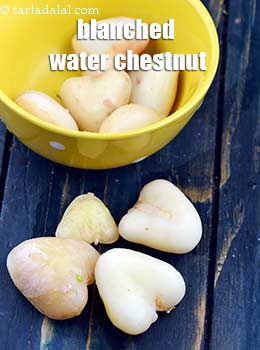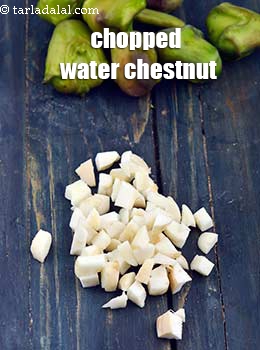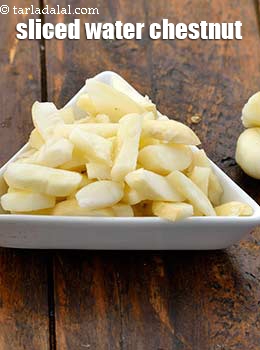The water chestnut is actually not a nut at all, but an aquatic vegetable that grows in marshes. The name "water chestnut" comes from the fact that it resembles a chestnut in shape and colouring. Indigenous to Southeast Asia, it has been cultivated in India and China since ancient times. Sometimes called Singhara nut in India, the floating leaves are about 5 to 8 cm long and have hairy petioles 10 to 15 cm in length.
The fruit is about 2 cm in diameter. Fresh water chestnuts are available year-round in Asian markets, either packaged or in bins. Unless you live in an area where they are grown locally, they are generally not available in local groceries and supermarkets. Canned water chestnuts are available year round at most groceries and supermarkets.
![]()
When choosing fresh water chestnuts, look for firm ones with an unwrinkled skin and no soft spots - otherwise when you peel the water chestnut you may find it has softened and turned mushy. Generally, it's best to buy a few more chestnuts than needed, just in case a few have spoiled.
Culinary Uses of fresh water chestnut, singhada, singhara in Indian Cooking
Indian stir fry using singhada, fresh water chestnut
1. water chestnuts and purple cabbage stir fry recipe | healthy Indian purple cabbage stir fry | red cabbage stir fry | easy 10 minute cabbage stir fry |
water chestnuts and purple cabbage stir fry is a quick and nourishing fare which can be enjoyed at any time of the day. Learn how to make healthy purple cabbage stir fry.
Amazing flavour, exciting mouth-feel, irresistible aroma – the red cabbage stir fry has it all. A unique combination of water chestnuts and cabbage is stir-fried with garlic and a sweet-spicy-tangy dressing, which gives the dish a very unique flavour and aroma.
A garnish of peanuts adds to the magic, making this easy 10 minute cabbage stir fry an undeniably awesome dish!
2. Stir Fried Water Chestnuts : For water chestnut lovers this is the best way to eat them clean and healthy as they are stir fried in olive oil with garlic and chilli flakes. The garlic and chilli flakes coat the water chestnuts really well to give a nice garlic flavor.
Indian pancakes with fresh water chestnuts
Quinoa and Ragi Pancakes : Delicious pancakes made of quinoa and ragi flours are stuffed with a unique filling of mushrooms and water chestnuts, and topped with a pleasantly-coloured, gooey-textured beet cheese sauce.
The Quinoa and Ragi Pancakes with Mushroom and Water Chestnut Filling and Beet Sauce looks awesome and tastes outta-this-world! Serve it immediately on preparation.
· Fresh water chestnuts need to be peeled and the top cut off before using. Before using canned water chestnuts, rinse them under warm running water to remove any "tinny" taste.
· Water chestnuts are frequently added to stir-fries, stuffing, and dumpling fillings for extra texture and a sweet flavour
· When steamed, the outside covering becomes blackened and it tastes starchy, sort of like a potato.
How to store fresh water chestnut, singhada, singhara
Unpeeled, fresh water chestnuts will keep for up to two weeks in a plastic bag in the refrigerator. Prior to cooking, you'll need to cut off the top and peel the skin. If you want to peel them ahead of time, that's fine, but be sure to store them in cold water in the refrigerator, with the water changed daily. Store canned water chestnuts in a cool dry place and use within a year. Once opened, store the water chestnuts in a sealed container in the refrigerator and use within three days.
Health benefits of fresh water chestnut, singhada, singhara
· Water chestnut is not so high calorie vegetable with some amounts of protein and almost negligible fat. Their high fibre count makes them a suitable of choice for weight watchers. However, its carb count should also be considered. The low sodium and high potassium content is beneficial for those with high blood pressure. The flavonoids present in water chestnuts are considered to be beneficial to the heart and some studies have shown that it can prevent cancer too! These flavonoids are antioxidants which can also help ward off free radicals from the body and reduce oxidative stress. Traditionally, this vegetable is also known to increase fertility in men by enhancing their sperm count. Small amounts of B vitamins along with the antioxidants it possesses can also be beneficial for your skin and hair.Blanched water chestnut

Wash the water chestnut well with water, drain and deseed each water chestnut fruit by carefully slitting using a sharp knife on one side and pulling out the water chestnut. Keep it whole or cut the water chestnut in pieces as required. Blanching can be done by boiling or steaming. Put the water chestnut in a wire basket, submerge them completely in the boiling water, cover with a lid, and blanch for 3-4 minutes. To blanch by steaming, put them in a steamer basket and suspend it above an inch or two of boiling water. Cover the pot, and begin timing (3-4 minutes) as soon as steam starts to escape from under the lid. With either method, shake the basket a couple of times to ensure that all surfaces are exposed to the heat. After the allotted time, remove the basket, and plunge the chestnuts into a bowl of ice water to stop the cooking. Once cool, remove them, drain thoroughly and add to your recipe.
Boiled water chestnut

Wash the water chestnut well with water, drain and deseed each water chestnut fruit by carefully slitting using a sharp knife on one side and pulling out the water chestnut. Keep it whole or cut the water chestnut in pieces as required. Immerse them in boiling water and boil for 10 to 15 minutes to get boiled water chestnuts. After the allotted time plunge the chestnuts into a bowl of ice water to stop the cooking. Once cool, remove them, drain thoroughly and add to your recipe.
Chopped water chestnut

To chop water chestnut wash them well with water, drain and deseed each water chestnut fruit by carefully slitting using a sharp knife on one side and pulling out the water chestnut. Then place each water chestnut on a chopping board and make 1 to 2 vertical slits on it using a sharp knife. Line all the vertical pieces together and chop horizontally at regular intervals to get chopped water chestnut. You can chop them finely or roughly as per recipe requirements.
Par boiled water chestnut

Water chestnuts can be used whole, halved, sliced, diced, cut into julienne strips, or puréed before par boiling them. Parboiling is a cooking technique in which water chestnuts are partially cooked in boiling water, but removed before it is cooked all the way through. Many recipes call for parboiled water chestnuts as they longer to cook. Parboiling them in advances ensures that they get completely cooked in the final dish.
Sliced water chestnut

To slice water chestnut wash them well with water, drain and deseed each water chestnut fruit by carefully slitting using a sharp knife on one side and pulling out the water chestnut. Then place each water chestnut on a chopping board and make 3 to 4 vertical slits on it using a sharp knife.
Water chestnut strips

Peel the waterchestnut and place it on a chopping board. Using a sharp knife, cut the waterchestnuts into 4 to 5 strips or as per required thickness vertically and use as required.